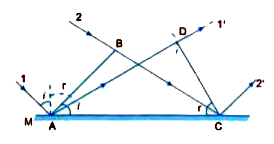What is a wavefront? How does it propagate? Using Huygens' principle, explain reflection of a plane wavefront from a surface and verify the laws of reflection.
A wavefront is defined as a surface of constant phase. Propagation of a wavefront is based on following two points:
(i) Every point on a given wavefront acts as fresh source of secondary wavelets, which travel in all directions with the speed of wave (i.e., of light) in the medium.
(ii) The common envelope (tangent) of these secondary wavelets in the forward direction gives the new wavefront at that instant.
Let us consider a plane wavefront AB incident obliquely on a plane reflecting surface MM.. Let one end A of wavefront strikes the mirror at an angle i but the other end B has still to cover distance BC. Time required for this will be , where c is the speed of light.
According to Huygen.s principle point A starts emitting secondary wavelets and in time t, these will cover a distance and spread. Hence, with point A as centre and BC as radius, draw a circular arc. Draw tangent CD on this arc from the point C. Obviously, CD is the reflected wavefront inclined at an angle r. Obviously the incident and reflected both are in the plane of paper.

Again in , we have
(by construction)
and AC is common.
So, the two triangles are congruent and,
hence,
or i.e., the angle of reflection is equal to the angle of incidence.
Topper's Solved these Questions
- CBSE EXAMINATION PAPER 2020 Book:U-LIKE SERIESChapter:CBSE EXAMINATION PAPER 2020 Exercise:SECTION C
Explore 10 Videos
- ATOMSBook:U-LIKE SERIESChapter:ATOMSExercise:SELF ASSESSMENT TEST (SECTION C)
Explore 2 Videos
- CBSE EXAMINATION PAPER 2020 (SOLVED)Book:U-LIKE SERIESChapter:CBSE EXAMINATION PAPER 2020 (SOLVED)Exercise:SECTION D
Explore 11 Videos
Similar Questions
(a) What is a wave front? How does it propagate? Using Huygens' principle, explain reflection of a plane wavefront from a surface and verify the laws of reflection. (b) A parallel beam of light of wavelength 500 nm falls on a narrow slit and the resulting diffraction pattern is obtained on a screen 1 m away. If the first minimum is formed at a distance of 2.5 mm from the centre of screen, find the (i) width of the slit, and (ii) distance of first secondary maximum from the centre of the screen.
View SolutionAnswer the following:
(a) What is a wave front? How does it propagate? Using Huygens' principle, explain reflection of a plane wavefront from a surface and verify the laws of reflection.
(b) A parallel beam of light of wavelength 500nm falls on a narrow slit and the resulting diffraction pattern is obtained on a screen 1m away. If the first minimum is formed at a distance of 2.5mm from the centre of screen, find the
(i) width of the slit, and
(ii) distance of first secondary maximum from the centre of the screen.
View SolutionUsing Huygen's construction, explain reflection of a plane wave by a plane surface.
View SolutionUsing Huygens' principle, establish the law of reflection.
View SolutionDefine a wavefront . Using Huygens principle ,verify the laws of reflection at a plane surface.
View SolutionDefine a wavefront. Using Huygen's principle, verifyi the laws of reflection at a plane surface.
View SolutionDefine the term wavefront. Using Huygens' wave theory, verify the laws of reflection.
View SolutionDefine a wavefront. Use huygen's principle to verify the laws of defraction.
View SolutionUse Huygen's principle to show how a plane wavefront propagates from a denser to rarer medium. Hence, verify snell's law of refraction.
View SolutionUse Huygen's principle to show how a plane wavefront propagates from a denser to rarer medium. Hence verift snell's law of refreaction.

View Solution

